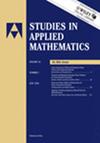求助PDF
{"title":"具有slater型修正的中子星Chandrasekhar变分问题的渐近行为","authors":"Deke Li, Qingxuan Wang","doi":"10.1111/sapm.70058","DOIUrl":null,"url":null,"abstract":"<div>\n \n <p>In this paper, we consider the Chandrasekhar variational model for neutron stars with defocusing Slater-type modifications. First, we show the existence and nonexistence of the ground state <span></span><math>\n <semantics>\n <msub>\n <mi>ρ</mi>\n <mi>ε</mi>\n </msub>\n <annotation>$\\rho _{\\varepsilon }$</annotation>\n </semantics></math> by concentration–compactness method, and particularly use two auxiliary functions to prove the strongly binding inequality. Second, we characterize perturbation limit behaviors of ground states <span></span><math>\n <semantics>\n <msub>\n <mi>ρ</mi>\n <mi>ε</mi>\n </msub>\n <annotation>$\\rho _{\\varepsilon }$</annotation>\n </semantics></math> as <span></span><math>\n <semantics>\n <mrow>\n <mi>ε</mi>\n <mo>→</mo>\n <msup>\n <mn>0</mn>\n <mo>+</mo>\n </msup>\n </mrow>\n <annotation>$\\varepsilon \\rightarrow 0^+$</annotation>\n </semantics></math> and obtain two different blow-up profiles corresponding to two limit equations for <span></span><math>\n <semantics>\n <mrow>\n <mi>N</mi>\n <mo>=</mo>\n <msub>\n <mi>N</mi>\n <mo>∗</mo>\n </msub>\n </mrow>\n <annotation>$N= N_*$</annotation>\n </semantics></math> and <span></span><math>\n <semantics>\n <mrow>\n <mi>N</mi>\n <mo>></mo>\n <msub>\n <mi>N</mi>\n <mo>∗</mo>\n </msub>\n </mrow>\n <annotation>$N> N_*$</annotation>\n </semantics></math>, where <span></span><math>\n <semantics>\n <mi>ε</mi>\n <annotation>$\\varepsilon$</annotation>\n </semantics></math> is a parameter corresponding to Slater-type modifications, and <span></span><math>\n <semantics>\n <msub>\n <mi>N</mi>\n <mo>∗</mo>\n </msub>\n <annotation>$N_*$</annotation>\n </semantics></math> is a threshold value related to the <i>Chandrasekhar limit</i>. Finally, we study the limit behaviors for <span></span><math>\n <semantics>\n <mrow>\n <mi>N</mi>\n <mo>≥</mo>\n <msub>\n <mi>N</mi>\n <mo>∗</mo>\n </msub>\n </mrow>\n <annotation>$N\\ge N_*$</annotation>\n </semantics></math> as <span></span><math>\n <semantics>\n <mrow>\n <mi>ε</mi>\n <mo>→</mo>\n <mo>+</mo>\n <mi>∞</mi>\n </mrow>\n <annotation>$\\varepsilon \\rightarrow +\\infty$</annotation>\n </semantics></math>, using some iterate arguments, we obtain a vanishing rate for <span></span><math>\n <semantics>\n <msub>\n <mi>ρ</mi>\n <mi>ε</mi>\n </msub>\n <annotation>$\\rho _{\\varepsilon }$</annotation>\n </semantics></math> that <span></span><math>\n <semantics>\n <mrow>\n <mrow>\n <mo>∥</mo>\n </mrow>\n <msub>\n <mi>ρ</mi>\n <mi>ε</mi>\n </msub>\n <msub>\n <mo>∥</mo>\n <msup>\n <mi>L</mi>\n <mi>∞</mi>\n </msup>\n </msub>\n <mo>≲</mo>\n <msup>\n <mi>ε</mi>\n <mrow>\n <mo>−</mo>\n <mfrac>\n <mn>1</mn>\n <mrow>\n <mi>α</mi>\n <mo>−</mo>\n <mn>1</mn>\n </mrow>\n </mfrac>\n </mrow>\n </msup>\n </mrow>\n <annotation>$\\Vert \\rho _\\varepsilon \\Vert _{L^\\infty }\\lesssim \\varepsilon ^{-\\frac{1}{\\alpha -1}}$</annotation>\n </semantics></math> as <span></span><math>\n <semantics>\n <mrow>\n <mi>ε</mi>\n <mo>→</mo>\n <mo>+</mo>\n <mi>∞</mi>\n </mrow>\n <annotation>$\\varepsilon \\rightarrow +\\infty$</annotation>\n </semantics></math> for any <span></span><math>\n <semantics>\n <mrow>\n <mn>4</mn>\n <mo>/</mo>\n <mn>3</mn>\n <mo><</mo>\n <mi>α</mi>\n <mo><</mo>\n <mo>+</mo>\n <mi>∞</mi>\n </mrow>\n <annotation>$4/3<\\alpha <+\\infty$</annotation>\n </semantics></math>. Moreover, we characterize the limit behaviors of the energy <span></span><math>\n <semantics>\n <mrow>\n <msub>\n <mi>E</mi>\n <mi>ε</mi>\n </msub>\n <mrow>\n <mo>(</mo>\n <mi>N</mi>\n <mo>)</mo>\n </mrow>\n </mrow>\n <annotation>$E_\\varepsilon (N)$</annotation>\n </semantics></math> with respect to <span></span><math>\n <semantics>\n <mi>ε</mi>\n <annotation>$\\varepsilon$</annotation>\n </semantics></math>, and show that <span></span><math>\n <semantics>\n <mrow>\n <msub>\n <mi>lim</mi>\n <mrow>\n <mi>ε</mi>\n <mo>→</mo>\n <mo>+</mo>\n <mi>∞</mi>\n </mrow>\n </msub>\n <msub>\n <mi>E</mi>\n <mi>ε</mi>\n </msub>\n <mrow>\n <mo>(</mo>\n <mi>N</mi>\n <mo>)</mo>\n </mrow>\n <mo>=</mo>\n <mi>m</mi>\n <mi>N</mi>\n </mrow>\n <annotation>$\\lim _{\\varepsilon \\rightarrow +\\infty }E_\\varepsilon (N)=mN$</annotation>\n </semantics></math>, <span></span><math>\n <semantics>\n <mrow>\n <msub>\n <mi>E</mi>\n <mi>ε</mi>\n </msub>\n <mrow>\n <mo>(</mo>\n <mi>N</mi>\n <mo>)</mo>\n </mrow>\n </mrow>\n <annotation>$E_\\varepsilon (N)$</annotation>\n </semantics></math> is concave and strictly monotonically increasing with respect to <span></span><math>\n <semantics>\n <mrow>\n <mi>ε</mi>\n <mo>></mo>\n <mn>0</mn>\n </mrow>\n <annotation>$\\varepsilon >0$</annotation>\n </semantics></math> in some case.</p></div>","PeriodicalId":51174,"journal":{"name":"Studies in Applied Mathematics","volume":"154 5","pages":""},"PeriodicalIF":2.6000,"publicationDate":"2025-05-15","publicationTypes":"Journal Article","fieldsOfStudy":null,"isOpenAccess":false,"openAccessPdf":"","citationCount":"0","resultStr":"{\"title\":\"Asymptotic Behaviors of Chandrasekhar Variational Problem for Neutron Stars With Slater-Type Modification\",\"authors\":\"Deke Li, Qingxuan Wang\",\"doi\":\"10.1111/sapm.70058\",\"DOIUrl\":null,\"url\":null,\"abstract\":\"<div>\\n \\n <p>In this paper, we consider the Chandrasekhar variational model for neutron stars with defocusing Slater-type modifications. First, we show the existence and nonexistence of the ground state <span></span><math>\\n <semantics>\\n <msub>\\n <mi>ρ</mi>\\n <mi>ε</mi>\\n </msub>\\n <annotation>$\\\\rho _{\\\\varepsilon }$</annotation>\\n </semantics></math> by concentration–compactness method, and particularly use two auxiliary functions to prove the strongly binding inequality. Second, we characterize perturbation limit behaviors of ground states <span></span><math>\\n <semantics>\\n <msub>\\n <mi>ρ</mi>\\n <mi>ε</mi>\\n </msub>\\n <annotation>$\\\\rho _{\\\\varepsilon }$</annotation>\\n </semantics></math> as <span></span><math>\\n <semantics>\\n <mrow>\\n <mi>ε</mi>\\n <mo>→</mo>\\n <msup>\\n <mn>0</mn>\\n <mo>+</mo>\\n </msup>\\n </mrow>\\n <annotation>$\\\\varepsilon \\\\rightarrow 0^+$</annotation>\\n </semantics></math> and obtain two different blow-up profiles corresponding to two limit equations for <span></span><math>\\n <semantics>\\n <mrow>\\n <mi>N</mi>\\n <mo>=</mo>\\n <msub>\\n <mi>N</mi>\\n <mo>∗</mo>\\n </msub>\\n </mrow>\\n <annotation>$N= N_*$</annotation>\\n </semantics></math> and <span></span><math>\\n <semantics>\\n <mrow>\\n <mi>N</mi>\\n <mo>></mo>\\n <msub>\\n <mi>N</mi>\\n <mo>∗</mo>\\n </msub>\\n </mrow>\\n <annotation>$N> N_*$</annotation>\\n </semantics></math>, where <span></span><math>\\n <semantics>\\n <mi>ε</mi>\\n <annotation>$\\\\varepsilon$</annotation>\\n </semantics></math> is a parameter corresponding to Slater-type modifications, and <span></span><math>\\n <semantics>\\n <msub>\\n <mi>N</mi>\\n <mo>∗</mo>\\n </msub>\\n <annotation>$N_*$</annotation>\\n </semantics></math> is a threshold value related to the <i>Chandrasekhar limit</i>. Finally, we study the limit behaviors for <span></span><math>\\n <semantics>\\n <mrow>\\n <mi>N</mi>\\n <mo>≥</mo>\\n <msub>\\n <mi>N</mi>\\n <mo>∗</mo>\\n </msub>\\n </mrow>\\n <annotation>$N\\\\ge N_*$</annotation>\\n </semantics></math> as <span></span><math>\\n <semantics>\\n <mrow>\\n <mi>ε</mi>\\n <mo>→</mo>\\n <mo>+</mo>\\n <mi>∞</mi>\\n </mrow>\\n <annotation>$\\\\varepsilon \\\\rightarrow +\\\\infty$</annotation>\\n </semantics></math>, using some iterate arguments, we obtain a vanishing rate for <span></span><math>\\n <semantics>\\n <msub>\\n <mi>ρ</mi>\\n <mi>ε</mi>\\n </msub>\\n <annotation>$\\\\rho _{\\\\varepsilon }$</annotation>\\n </semantics></math> that <span></span><math>\\n <semantics>\\n <mrow>\\n <mrow>\\n <mo>∥</mo>\\n </mrow>\\n <msub>\\n <mi>ρ</mi>\\n <mi>ε</mi>\\n </msub>\\n <msub>\\n <mo>∥</mo>\\n <msup>\\n <mi>L</mi>\\n <mi>∞</mi>\\n </msup>\\n </msub>\\n <mo>≲</mo>\\n <msup>\\n <mi>ε</mi>\\n <mrow>\\n <mo>−</mo>\\n <mfrac>\\n <mn>1</mn>\\n <mrow>\\n <mi>α</mi>\\n <mo>−</mo>\\n <mn>1</mn>\\n </mrow>\\n </mfrac>\\n </mrow>\\n </msup>\\n </mrow>\\n <annotation>$\\\\Vert \\\\rho _\\\\varepsilon \\\\Vert _{L^\\\\infty }\\\\lesssim \\\\varepsilon ^{-\\\\frac{1}{\\\\alpha -1}}$</annotation>\\n </semantics></math> as <span></span><math>\\n <semantics>\\n <mrow>\\n <mi>ε</mi>\\n <mo>→</mo>\\n <mo>+</mo>\\n <mi>∞</mi>\\n </mrow>\\n <annotation>$\\\\varepsilon \\\\rightarrow +\\\\infty$</annotation>\\n </semantics></math> for any <span></span><math>\\n <semantics>\\n <mrow>\\n <mn>4</mn>\\n <mo>/</mo>\\n <mn>3</mn>\\n <mo><</mo>\\n <mi>α</mi>\\n <mo><</mo>\\n <mo>+</mo>\\n <mi>∞</mi>\\n </mrow>\\n <annotation>$4/3<\\\\alpha <+\\\\infty$</annotation>\\n </semantics></math>. Moreover, we characterize the limit behaviors of the energy <span></span><math>\\n <semantics>\\n <mrow>\\n <msub>\\n <mi>E</mi>\\n <mi>ε</mi>\\n </msub>\\n <mrow>\\n <mo>(</mo>\\n <mi>N</mi>\\n <mo>)</mo>\\n </mrow>\\n </mrow>\\n <annotation>$E_\\\\varepsilon (N)$</annotation>\\n </semantics></math> with respect to <span></span><math>\\n <semantics>\\n <mi>ε</mi>\\n <annotation>$\\\\varepsilon$</annotation>\\n </semantics></math>, and show that <span></span><math>\\n <semantics>\\n <mrow>\\n <msub>\\n <mi>lim</mi>\\n <mrow>\\n <mi>ε</mi>\\n <mo>→</mo>\\n <mo>+</mo>\\n <mi>∞</mi>\\n </mrow>\\n </msub>\\n <msub>\\n <mi>E</mi>\\n <mi>ε</mi>\\n </msub>\\n <mrow>\\n <mo>(</mo>\\n <mi>N</mi>\\n <mo>)</mo>\\n </mrow>\\n <mo>=</mo>\\n <mi>m</mi>\\n <mi>N</mi>\\n </mrow>\\n <annotation>$\\\\lim _{\\\\varepsilon \\\\rightarrow +\\\\infty }E_\\\\varepsilon (N)=mN$</annotation>\\n </semantics></math>, <span></span><math>\\n <semantics>\\n <mrow>\\n <msub>\\n <mi>E</mi>\\n <mi>ε</mi>\\n </msub>\\n <mrow>\\n <mo>(</mo>\\n <mi>N</mi>\\n <mo>)</mo>\\n </mrow>\\n </mrow>\\n <annotation>$E_\\\\varepsilon (N)$</annotation>\\n </semantics></math> is concave and strictly monotonically increasing with respect to <span></span><math>\\n <semantics>\\n <mrow>\\n <mi>ε</mi>\\n <mo>></mo>\\n <mn>0</mn>\\n </mrow>\\n <annotation>$\\\\varepsilon >0$</annotation>\\n </semantics></math> in some case.</p></div>\",\"PeriodicalId\":51174,\"journal\":{\"name\":\"Studies in Applied Mathematics\",\"volume\":\"154 5\",\"pages\":\"\"},\"PeriodicalIF\":2.6000,\"publicationDate\":\"2025-05-15\",\"publicationTypes\":\"Journal Article\",\"fieldsOfStudy\":null,\"isOpenAccess\":false,\"openAccessPdf\":\"\",\"citationCount\":\"0\",\"resultStr\":null,\"platform\":\"Semanticscholar\",\"paperid\":null,\"PeriodicalName\":\"Studies in Applied Mathematics\",\"FirstCategoryId\":\"100\",\"ListUrlMain\":\"https://onlinelibrary.wiley.com/doi/10.1111/sapm.70058\",\"RegionNum\":2,\"RegionCategory\":\"数学\",\"ArticlePicture\":[],\"TitleCN\":null,\"AbstractTextCN\":null,\"PMCID\":null,\"EPubDate\":\"\",\"PubModel\":\"\",\"JCR\":\"Q1\",\"JCRName\":\"MATHEMATICS, APPLIED\",\"Score\":null,\"Total\":0}","platform":"Semanticscholar","paperid":null,"PeriodicalName":"Studies in Applied Mathematics","FirstCategoryId":"100","ListUrlMain":"https://onlinelibrary.wiley.com/doi/10.1111/sapm.70058","RegionNum":2,"RegionCategory":"数学","ArticlePicture":[],"TitleCN":null,"AbstractTextCN":null,"PMCID":null,"EPubDate":"","PubModel":"","JCR":"Q1","JCRName":"MATHEMATICS, APPLIED","Score":null,"Total":0}
引用次数: 0
引用
批量引用

 求助内容:
求助内容: 应助结果提醒方式:
应助结果提醒方式:


